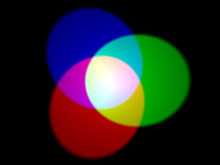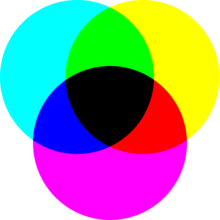Color mixing
Overveiw
There are two types of color mixing: Additive and Subtractive. In both cases there are three primary colors, three secondary colors (colors made from 2 of the three primary colors in equal amounts), and one tertiary color made from all three primary colors.



Additive Mixing
Additive mixing of colors generally involves mixing colors of light. In additive mixing of colors there are three primary colors: red, green, and blue. In the absence of color or, when no colors are showing, the result is black. If all three primary colors are showing, the result is white. When red and green combine, the result is yellow. When red and blue combine, the result is magenta. When green and blue combined, the result is cyan.
Uses in Computing
In HTML programming, it can be useful to know some of the rules of additive mixing, and a little hexadecimal. To use a color code in HTML, you have to put a "#" before your color so that the computer knows that a color is coming. Then, you add a six-digit code after the # symbol. The 1st tw digits are the red value, the middle two are green, and the last two are blue. your code would look something like this for white: #ffffff For example, if you wanted to make text appear red, you would type something like <font color="#ff0000">red</font>.
Subtractive Mixing
In subtractive mixing of colors, you are generally mixing either paint or ink. The three primary colors and subtractive mixing of are yellow, magenta, and cyan. In subtractive mixing of color, the absence of color is black and the presence of all three primary colors is white. You may have already begun to notice from the pictures on the right, the additive and subtractive mixing of colors are just the exact opposites. In subtractive mixing of colors, the secondary colors are the same as the primary colors from additive mixing, and vice versa.
References
Macaulay, David and Neil Ardley (1988). The New Way Things Work. London: Dorling Kindersley Ltd. ISBN 0395938473.
